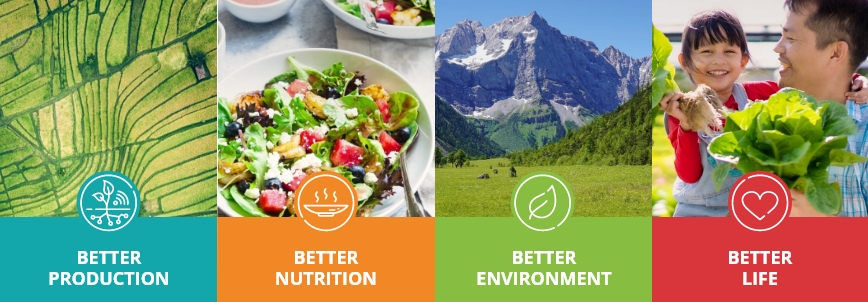About the RTP on Green Agriculture
Green agriculture means actioning a green agenda into agrifood system policies to achieve agrifood system transformation to ensure food security for all. It is an important element for transforming local food systems by reducing the toll on natural resources, avoiding environmental degradation through high recycling rates and low use of external inputs while reducing poverty, increasing livelihoods and ensuring nutritional needs through sustainable policies and practices.
Natural resources are the foundation of local food systems, and it is clear that without land, water and biodiversity we could not produce, commercialize or eat our food.
Over the past 20 years, there have been many changes in the way we look at food, owing in part to globalization, the processes of urbanization and technological development, changes in diet habits, the spread of health diseases, changes in access to international markets, and trade liberalization methods of managing natural resources to satisfy increasing needs in a changing climate. In addition, the COVID-19 pandemic has highlighted the fragility of the current food system.
Societies also have transformed their interactions with the environment, changing their Natural resources are the foundation of local food systems, and it is clear that without land, water and biodiversity we could not produce, commercialize or eat our food.
Enhancing the sustainability of the agricultural sector requires a systemic change towards higher productivity and also, essentially, lower output variability in the face of climate, a and socio‐economic risks. More productive and resilient agriculture requires profound transformations along the entire agrifood value chain, from production to distribution to consumption.

Could green agriculture be the answer?
Green agriculture is at the crossroads of the three dimensions of sustainability – economic, environmental and social – and contributes to achieving several Sustainable Development Goals.
Green agriculture involves the good management of natural resources, biodiversity and ecosystem services while building sustainable and resilient agroecosystems capable of tackling current and future challenges
It is an important element for transforming local food systems by reducing the toll on natural resources, avoiding environmental degradation through high recycling rates and low use of external inputs while reducing poverty, increasing livelihoods and ensuring nutritional needs through sustainable policies and practices.
Regional Technical Platform on Green Agriculture and the FAO Strategic Framework
The Regional Technical Platform on Green Agriculture provides a digital, user-friendly, open, intraregional and interregional gateway for sharing information. It is a knowledge repository that facilitates connections among expert networks regarding various technical areas related to green agriculture.
The Regional Technical Platform on Green Agriculture aims at contributing to more efficient, inclusive, resilient and sustainable agrifood systems, in line with the FAO Strategic Framework and under the so-called “four betters” – better production, better nutrition, a better environment and a better life – while leaving no one behind.

How does the platform works?
The three components of the Regional Technical Platform on Green Agriculture respond to three main objectives:
- Share successful experiences and facilitate an interregional exchange of good practices in which FAO and its development partners in the region have a comparative advantage on technical areas of work that can be relevant within the region and to other regions.
- Build on existing regional-level technical networks to further build, connect and strengthen regional and interregional technical networks.
- Create a knowledge repository with key information about the selected technical topics, focusing on normative work, projects, initiatives and programmes of FAO and partners.
The platform is intended for government officers, farmers and farmers’ organizations, academia, civil society, non-governmental organizations, youth, women, and indigenous communities, all of which need access to qualified knowledge on green agriculture and related topics.
The platform welcomes the contributions of all interested entities willing to participate in the project by sending factual, notable, verifiable and neutrally presented content and best practices on the thematic areas of green agriculture.
Using the platform as a knowledge reference on green agriculture can assist policymakers and other interested stakeholders by facilitating discussion, policy and programme design on green agriculture.
The Secretariat of the Regional Technical Platform on Green Agriculture is the coordination and facilitation body in charge of enabling the implementation of Regional Technical Platform actions through its regional and interregional partnerships and networks.
The Secretariat is hosted by FAO, in view of its global mandate.
Hosted by FAO, the platform benefits from the active collaboration of contributors, including European Union institutions, international organizations and the FAO Regional Office for Europe and Central Asia (REU), together with the FAO Subregional Office for Central Asia (SEC) and FAO country offices in the region. Other important contributors include governments, other United Nations agencies, research centres, academia, and private sector entities specializing in topics related to green agriculture.
The Regional Green Agriculture Partnership (RGAP) is a strong partnership of national and international stakeholders that will reinforce the three components of the Green Agriculture Platform:
i) the sharing of experiences and good practices;
ii) an interregional network of experts; and
iii) a knowledge repository.
The Regional Technical Platform on Green Agriculture will be the main body of governance to mainstream green agriculture in Europe and Central Asia, acting as a catalyst to enable the exchange of information and to start generating medium- and long-term programmes and projects.

